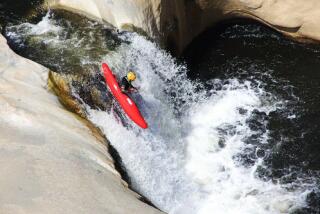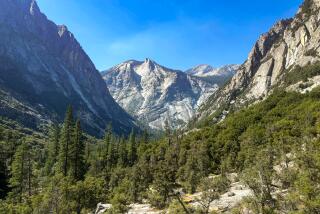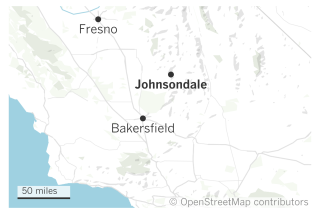An inside-out adventure canyoneering in Utah
- Share via
SPRINGDALE, Utah — There comes a moment when you step backward off a cliff, clinging to a rope the width of your pinkie, and ask yourself, “Why am I doing this?”
It’s inevitable. Fear of heights (and its close cousin, fear of falling) is as deeply ingrained in most of us as fear of sharks or snakes. Sometimes, though, confronting these fears is the first step to discovering a new world — a coral reef, the Amazon rainforest or the convoluted landscape of southern Utah, near Zion National Park, revealed through the fast-growing sport of canyoneering.
“Canyoneering opens up new doors of exploration,” said Jonathan Zambella, a veteran climber who started Zion Adventure Co. in 1996 in Springdale. “It’s a real adventure that real people — people with desk jobs, who work in grocery stores, who are moms and dads or children — can enjoy.”
Unlike climbing, which typically requires working one’s way up, canyoneering involves working your way down an often-narrow canyon using a variety of techniques, including rappelling, scrambling and sometimes even wading or swimming (the narrow canyons can hide deep pools). By following the course carved by millions of years of water flow, you’ll descend to where the canyon opens, on level terrain.
“If you’ve hiked the Grand Canyon,” said Bill Westerhoff (who, along with Kim Molyneux, guided our group of six through the day’s expedition), “you’ve been canyoneering.”
Well, not exactly. Our dawn-to-dusk day trip was more technical than trail hiking and a little scarier. But it was a revelation: a chance to explore hidden corners of the planet that, without canyoneering skills, would be inaccessible.
The purple sky was still flecked with stars when we met at Zion Adventure Co. at 6 a.m., collected our gear and set off in two beefy SUVs. Our destination was Birch Hollow, a local favorite recommended by Zambella. We would take both cars to Orderville Corral, where the canyon transit ends, drop one off, then squeeze into the other and drive back to the entrance point.
“Birch Hollow has always been one of my favorite canyons in the Zion area because it’s secluded, and slightly more off the radar than a lot of the others,” Bill, an affable outdoorsman who vaguely reminded me of Bill Murray, said as we bumped along North Fork Road. “It’s a very picturesque canyon; just a whole lot of fun.”
Commercial canyoneering isn’t allowed in Zion; we were on a dirt road just east of the national park. Most of the other pickups we passed carried hunters gunning for mule deer. The road was lined with forest. After a few miles, we pulled off at the trailhead. It was late October, cold enough to frost our breath. But the sun would warm things up — eventually.
I would never have guessed that a red rock slot canyon penetrated this area. But Utah is an origami state, folded in ways one can hardly imagine. In the past, the best canyons were often discovered haphazardly; today, Google Earth and Google Maps have made finding these labyrinthine channels much easier. There are scores, possibly hundreds of navigable canyons in the Zion area; the Canyoneering USA website (www.canyoneeringusa.com) describes no fewer than 32, with names such as Das Boot and Fat Man’s Misery.
“This is one of the more risky activities we’ll be doing today,” said Bill as my friends and I hiked along a precarious trail toward the first of our 10 descents that would take us into and through Birch Hollow. “You can slip and fall, or scrape yourself on a log or a rock, whereas later, when you’re hanging on a rope, you really can’t fall very far.”
But it certainly seemed as though you could. We reached our first rappel, a broad cliff about 135 feet high. I peered over the edge. Vertiginous as it seemed, it was just a teaser; we were not yet at the slot canyon.
Under the supervision of Bill and Kim, we set up our gear, clipped on our harnesses and — one by one, with a fast grip on the rope — began stepping backward, very slowly, over the cliff. The idea isn’t to “hang” on the rope and get lowered to the bottom. You want to walk down, staying perpendicular to the rock — even if that means walking down the cliff face itself, with your body parallel to the ground.
During my descent I glanced over my shoulder. The ground seemed very far away. But climbing rope is strong — very strong. This one tested for 4,000 pounds. I weigh 170; even I had to admit that was reasonably within the margin of safety.
As the day progressed, the canyon swallowed us up. Our rappels became less exposed and more thrilling. The occasional trees were aflame with autumn colors and the sky a band of gem-like blue above the towering walls. We made long descents down chutes of sculpted sandstone, our ropes lashed to time-tested stumps or fixed anchors. Altogether, we would descend more than 1,000 feet — half of it by rope.
There’s a fair amount of gear involved in canyoneering — helmets, harnesses, carabiners and metal loops called “piranas” that help to control the speed of your descent — but everything fits together simply. Once you’ve mastered a couple of basic knots, setting up each rappel becomes second nature. But you always double-check; your life depends on it.
Both Bill and the quieter Kim were excellent guides, relishing our learning curve. “The best teachers challenge you,” Kim said, “and get you excited.”
“Is this knot good?” one friend asked before making a 100-foot rappel down a vertical, throat-like wash.
“You tell me,” Bill said with a grin. He would double-check, of course, but his technique was meant to spur our self-reliance. At first, we bristled at such comments. But as our skills sharpened, we became more confident and needed much less hand-holding.
As we journeyed deeper into the canyon, the sport’s appeal continued to grow on us. We were in a beautiful, remote place that could be seen only this way: from the inside out. I was reminded of that classic sci-fi movie “Fantastic Voyage,” in which a team of scientists is reduced to corpuscle-size and travels through the human bloodstream.
On the ninth rappel, we saw Birch Hollow’s best-known landmark. Descending the slick, 60-foot canyon face, we beheld a round, Mini Cooper-sized chockstone wedged between the walls above and to our left. Once we’d all reached the bottom, we stared up at the boulder — which clearly wasn’t going anywhere. Inevitably, though, the sight brought up images from the film “127 Hours.” Bill sensed our misgivings.
“How common was Aron Ralston’s accident? To knock over a boulder, have it fall and land on you, trapping your arm?” Bill shook his head. “It was a complete fluke. The main thing Ralston did wrong — and he’ll be the first to admit it — was to head out without letting anyone know where he was going. So no one knew where to look for him if something should happen — which it obviously did.”
One thing that had emerged during the day — as dramatic as the otherworldly scenery — was how well we had worked together as a team.
“This is why I typically prefer canyoneering to climbing,” Bill said as we set up for our final rappel. “Climbing is usually one person versus the rock, while in canyoneering, everybody uses teamwork to get through whatever obstacles the canyon throws at us.”
It was nearly sunset when we completed our final rappel and hiked out of Birch Hollow toward Orderville Corral and our waiting SUV. Any qualms I’d had about dangling from a rope 100 feet off the lip of a sheer red rock wall had been dispelled and replaced by mental calculations about how soon I might return.
A bright gibbous moon hung over the Kolob Plateau as we tossed our helmets and harnesses into the back of the truck. It’s funny, how even one day of canyoneering can transform the way one perceives a landscape. As I stared at the moon through my binoculars, it looked strangely inviting — a place with a lot of unexplored canyons.
More to Read
Sign up for The Wild
We’ll help you find the best places to hike, bike and run, as well as the perfect silent spots for meditation and yoga.
You may occasionally receive promotional content from the Los Angeles Times.






